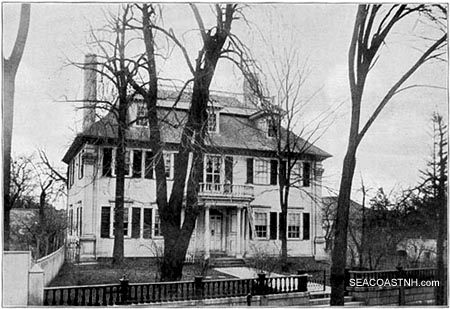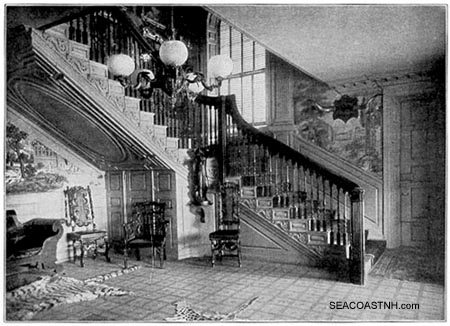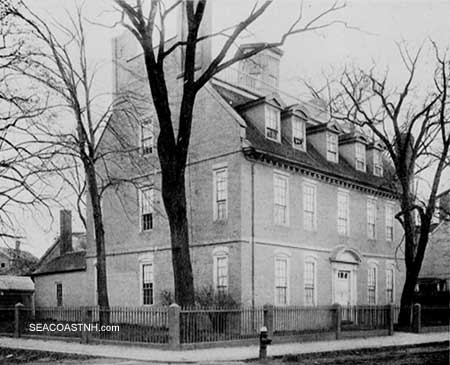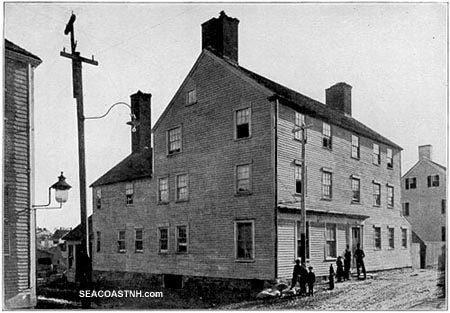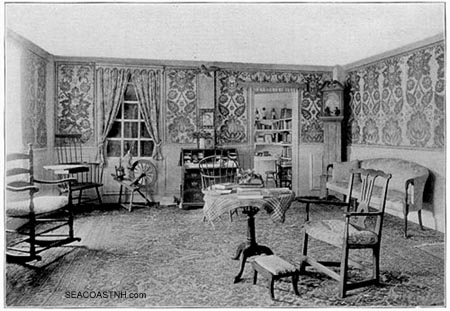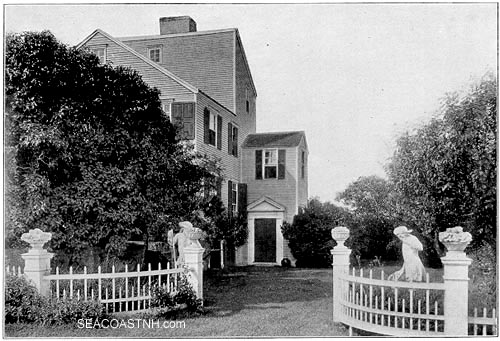|
FRESH STUFF DAILY |
|
|
||
|
|
||
|
|
||
|
SEE ALL SIGNED BOOKS by J. Dennis Robinson click here |
||
Aldrich continues his 1893 tour and visits the Langdon House, Warner House, the William Pitt Tavern, the Wentworth-Coolidge Mansion and the John Wentworth Home. Amazingly, all of these historic houses are still open to the public more than a century after the author’s demise – and his house too!
BACK to Chapter Three When Washington visited Portsmouth in 1789 he was not much impressed by the architecture of the little town that had stood by him so stoutly in the struggle for independence. "There are some good houses," he writes, in a diary kept that year during a tour through Connecticut, Massachusetts, and New Hampshire, "among which Colonel Langdon's may be esteemed the first; but in general they are indifferent, and almost entirely of wood. On wondering at this, as the country is full of stone and good clay for bricks, I was told that on account of the fogs and damp they deemed them wholesomer, and for that reason preferred wood buildings." The house of Colonel Langdon, on Pleasant Street, is an excellent sample of the solid and dignified abodes which our great-grand-sires had the sense to build. The art of their construction seems to have been a lost art these fifty years. Here Governor John Langdon resided from 1782 until the time of his death in 1819 -- a period during which many an illustrious man passed between those two white pillars that support the little balcony over the front door; among the rest Louis Philippe and his brothers, the Ducs de Montpensier and Beaujolais, and the Marquis de Chastellux, a major-general in the French army, serving under the Count de Rochambeau, whom he accompanied from France to the States in 1780.
The journal of the marquis contains this reference to his host: "After dinner we went to drink tea with Mr. Langdon. He is a handsome man, and of noble carriage; he has been a member of Congress, and is now one of the first people of the country; his house is elegant and well furnished, and the apartments admirably well wainscoted" (this reads like Mr. Samuel Pepys); "and he has a good manuscript chart of the harbor of Portsmouth. Mrs. Langdon, his wife, is young, fair, and tolerably handsome, but I conversed less with her than with her husband, in whose favor I was prejudiced from knowing that he had displayed great courage and patriotism at the time of Burgoyne's expedition." It was at the height of the French Revolution that the three sons of the Duc d' Orleans were entertained at the Langdon mansion. Years afterward, when Louis Philippe was on the throne of France, he inquired of a Portsmouth lady presented at his court if the mansion of brave Gouverneur Langdon was still in existence. The house stands back a decorous distance from the street, under the shadows of some gigantic oaks or elms, and presents an imposing appearance as you approach it over the tessellated marble walk. A hundred or two feet on either side of the gate, and abutting on the street, is a small square building of brick, one story in height-probably the porter's lodge and tool-house of former days. There is a large fruit garden attached to the house, wbich is in excellent condition, taking life comfortably, and having the complacent air of a well-preserved beau of the ancient regime. The Langdon mansion was owned and long occupied by the late Rev. Dr. Burroughs, for a period of forty-seven years the esteemed rector of St. John's Church. Continue OLD TOWN BY THE SEA A STROLL ABOUT TOWN by TB Aldrich (continued)
At the other end of Pleasant Street is an other notable house, to which we shall come by and by. Though President Washington found Portsmouth but moderately attractive from an architectural point of view, the visitor of to-day, if he have an antiquarian taste, will find himself embarrassed by the number of localities and buildings that appeal to his interest. Many of these buildings were new and undoubtedly commonplace enough at the date of Washington's visit; time and association have given them a quaintness and a significance which now make their architecture a question of secondary importance. One might spend a fortnight in Portsmouth exploring the nooks and corners over which history has thrown a charm, and by no means exhaust the list. I can not do more than attempt to describe -- and that very briefly -- a few of the typical old houses. On this same Pleasant Street there are several which we must leave unnoted, with their spacious halls and carven staircases, their antiquated furniture and old silver tankards and choice Copleys. Numerous examples of this artist's best manner are to be found here. To live in Portsmouth with out possessing a family portrait done by Copley is like living in Boston without having an ancestor in the old Granary Burying-Ground. You can exist, but you cannot be said to flourish. To make this statement smooth, I will remark that every one in Portsmouth has a Copley -- or would have if a fair division were made. In the better sections of the town the houses are kept in such excellent repair, and have so smart an appearance with their bright green blinds and freshly painted woodwork, that you are likely to pass many an old landmark without suspecting it. Whenever you see a house with a gambrel roof, you may be almost positive that the house is at least a hundred years old, for the gambrel roof went out of fashion after the Revolution. On the corner of Daniel and Chapel streets stands the oldest brick building in Portsmouth -- the Warner House. It was built in 1718 by Captain Archibald Macpheadris, a Scotchman, as his name indicates, a wealthy merchant, and a member of the King's Council. He was the chief projector of one of the earliest iron-works established in America. Captain Macpheadris married Sarah Wentworth, one of the sixteen children of Governor John Wentworth, and died in 1719, leaving a daughter, Mary, whose portrait, with that of her mother, painted by the ubiquitous Copley, still hangs in the parlor of this house, which is not known by the name of Captain Macpheadris, but by that of his son-in-law, Hon. Jonathan Warner, a member of the King's Council until the revolt of the colonies. "We well recollect Mr. Warner," says Mr. Brewster, writing in 1858, "As, one of the last of the cocked hats. As in a vision of early childhood he is still before us, in all the dignity of the aristocratic crown officers. That broad-backed, long-skirted brown coat, those small-clothes and silk stockings, those silver buckles, and that cane -- we see them still, although the life that filled and moved them ceased half a century ago." Continue OLD TOWN BY THE SEA A STROLL ABOUT TOWN by TB Aldrich (continued)
The Warner House, a three-story building with gambrel roof and luthern windows, is as fine and substantial an exponent of the architecture of the period as you are likely to meet with anywhere in New England. The eighteen-inch walls are of brick brought from Holland, as were also many of the materials used in the building -- the hearth stones, tiles, etc. Hewn - stone underpinnings were seldom adopted in those days; the brick-work rests directly upon the solid walls of the cellar. The interior is rich in paneling and wood carvings about the mantel-shelves, the deep-set windows, and along the cornices. The halls are wide and long, after a by-gone fashion, with handsome staircases, set at an easy angle, and not standing nearly upright, like those ladders by which one reaches the upper chambers of a modern house. The principal rooms are paneled to the ceiling, and have large open chimney - places, adorned with the quaintest of Dutch tiles. In one of the parlors of the Warner House there is a choice store of family relics -- china, silver-plate, costumes, old clocks, and the like. There are some interesting paintings, too -- not by Copley this time. On a broad space each side of the hall windows, at the head of the staircase, are pictures of two Indians, life size. They are probably portraits of some of the numerous chiefs with whom Captain Macpheadris had dealings, for the captain was engaged in the fur as well as in the iron business. Some enormous elk antlers, presented to Macpheadris by his red friends, are hanging in the lower hall. By mere chance, thirty or forty years ago, some long-hidden paintings on the walls of this lower hall were brought to light. In repairing the front entry it became necessary to remove the paper, of which four or five layers had accumulated. At one place, where the several coats had peeled off cleanly, a horse's hoof was observed by a little girl of the family. The workman then began removing the paper carefully; first the legs, then the body of a horse with a rider were revealed, and the astonished paper-hanger presently stood before a life-size representation of Governor Phipps on his charger. The workman called other persons to his assistance, and the remaining portions of the wall were speedily stripped, laying bare four or five hundred square feet covered with sketches in color, landscapes, views of unknown cities,-Biblical scenes, and modern figure-pieces, among which was a lady at a spinning-wheel. Until then no person in the land of the living had had any knowledge of those hidden pictures. An old dame of eighty, who had visited at the house intimately ever since her childhood, all but refused to believe her spectacles (though Supply Ham made them1) when brought face to face with the frescoes. The place is rich in bricabrac, but there is nothing more curious than these incongruous paintings, clearly the work of a practiced hand. Even the outside of the old edifice is not without its interest for an antiquarian. The lightning-rod which protects the Warner House to-day was put up under Benjamin Franklin's own supervision in 1762 -- such at all events is the credited tradition-and is supposed to be the first rod put up in New Hampshire. A lightning-rod "personally conducted" by Benjamin Franklin ought to be an attractive object to even the least susceptible electricity. The Warner House has another imperative claim on the good-will of the visitor -- it is not positively known that George Washington ever slept there. Note 1: In the early part of this century, Supply Ham was the leading optician and watchmaker of Portsmouth. Continue OLD TOWN BY THE SEA A STROLL ABOUT TOWN by TB Aldrich (continued)
The same assertion cannot safely be made in connection with the old yellow barracks situated on the southwest corner of Court and Atkinson streets. Famous old houses seem to have an intuitive perception of the value of corner lots. If it is a possible thing, they always set themselves down on the most desirable spots. It is beyond a doubt that Washington slept not only one night, but several nights, under this roof; for this was a celebrated tavern previous and subsequent to the War of Independence, and Washington made it his headquarters during his visit to Portsmouth in 1797. When I was a boy I knew an old lady -- not one of the preposterous old ladies in the newspapers, who have all their faculties unimpaired, but a real old lady, whose ninety nine years were beginning to tell on her -- who had known Washington very well. She was a girl in her teens when he came to Portsmouth. The President was the staple of her conversation during the last ten years of her life, which she passed in the Stavers House, bedridden, and I think those ten years were in a manner rendered short and pleasant to the old gentlewoman by the memory of a compliment to her complexion which Washington probably never paid to it. The old hotel -- now a very unsavory tenement-house -- was built by John Stavers, innkeeper, in 1770, who planted in front of the door a tall post, from which swung the sign of the Earl of Halifax. Stavers had previously kept an inn of the same name on Queen, now State Street. It is a square three-story building, shabby and dejected, giving no hint of the really important historical associations that cluster about it. At the time of its erection it was no doubt considered a rather grand structure, for buildings of three stories were rare in Portsmouth. Even in 1798, of the six hundred and twenty-six dwelling houses of which the town boasted, eighty-six were of one story, five hundred and twenty-four were of two stories, and only sixteen of three stories. The Stavers inn has the regulation gambrel roof, but is lacking in those wood ornaments which are usually seen over the doors and windows of the more prominent houses of that epoch. It was, however, the hotel of the period. That same worn doorstep upon which Mr. O'Shaughnessy now stretches himself of a summer afternoon, with a short clay pipe stuck between his lips, and his hat crushed down on his brows, revolving the sad vicissitude of things -- that same doorstep has been pressed by the feet of generals and marquises and grave dignitaries upon whom depended the destiny of the States-officers in gold lace and scarlet cloth, and high-heeled belles in patch, powder, and paduasoy. At this door the Flying Stage Coach, which crept from Boston, once a week set down its load of passengers -- and distinguished passengers they often were. Most of the chief celebrities of the land, before and after the secession of the colonies, were the guests of Master Stavers, at the sign of the Earl of Halifax. While the storm was brewing between the colonies and the mother country, it was in a back room of the tavern that the adherents of the crown met to discuss matters. The landlord himself was an amateur loyalist, and when the full cloud was on the eve of breaking he had an early intimation of the coming tornado. The Sons of Liberty had long watched with sullen eyes the secret sessions of the Tories in Master Stavers's tavern, and one morning the patriots quietly began cutting down the post which supported the obnoxious emblem. Mr. Stavers, who seems not to have been belligerent himself, but the cause of belligerence in others, sent out his black slave with orders to stop proceedings. The negro, who was armed with an axe, struck but a single blow and disappeared. This blow fell upon the head of Mark Noble; it did not kill him, but left him an insane man till the day of his death, forty years afterward. A furious mob at once collected, and made an attack on the tavern, bursting in the doors and shattering every pane of glass in the windows. It was only through the intervention of Captain John Langdon, a warm and popular patriot, that the hotel was saved from destruction. In the mean while Master Stavers had escaped through the stables in the rear. He fled to Stratham, where he was given refuge by his friend William Pottle, a most appropriately named gentleman, who had supplied the hotel with ale. The excitement blew over after a time, and Stavers was induced to return to Portsmouth. He was seized by the Committee of Safety, and lodged in Exeter jail, when his loyalty, which had really never been very high, went down below zero; he took the oath of allegiance, and shortly after his release reopened the hotel. The honest face of William Pitt appeared on the repentant sign, vice Earl of Halifax, ignominiously removed, and Stavers was himself again. In the state records is the following letter from poor Noble begging for the enlargement of John Stavers:-- PORTSMOUTH, February 3, 1777. GENTLEMEN, -- As I am informed that Mr. Stavers is in confinement in gaol upon my account contrary to my desire, for when I was at Mr. Stavers a fast day I had no ill nor ment none against the Gentleman but by bad luck or misfortune I have received a bad Blow but it is so well that I hope to go out in a day or two. So by this gentlemen of the Committee I hope you will release the gentleman upon my account. I am yours to serve. MARK NOBLE, A friend to my country. From that period until I know not what year the Stavers House prospered. It was at the sign of the William Pitt that the officers of French fleet boarded in 1782, and hither came the Marquis Lafayette, all the way from Providence, to visit them. John Hancock, Elbridge Gerry, Rutledge, and other signers of the Declaration sojourned here at various times. It was here General Knox--"that stalwart man, two officers in size and three in lungs "--was wont to order his dinner, and in a stentorian voice compliment Master Stavers on the excellence of his larder. One day -- it was at the time of the French Revolution -- Louis Philippe and his two brothers applied at the door of the William Pitt for lodgings; but the tavern was full, and the future king, with his companions, found comfortable quarters under the hospitable roof of Governor Langdon in Pleasant Street. Continue OLD TOWN BY THE SEA A STROLL ABOUT TOWN by TB Aldrich (continued)
A record of the scenes, tragic and humorous, that have been enacted within this old yellow house on the corner would fill a volume. A vivid picture of the social and public life of the old time might be painted by a skillful hand, using the two Earl of Halifax inns for a background. The painter would find gay and sombre pigments ready mixed for his palette, and a hundred romantic incidents waiting for his canvas. One of these romantic episodes has been turned to very pretty account by Longfellow in the last series of The Tales of a Wayside Inn -- the marriage of Governor Benning, Wentworth with Martha Hilton, a sort of second edition of King Cophetua and the Beggar Maid. Martha Hilton was a poor girl, whose bare feet and ankles and scant drapery when she was a child, and even after she was well in the bloom of her teens, used to scandalize good Dame Stavers, the innkeeper's wife. Standing one afternoon in the doorway of the Earl of Halifax,1 Dame Stavers took occasion to remonstrate with the sleek-limbed and lightly draped Martha, who chanced to be passing the tavern, carrying a pail of water, in which, as the poet neatly says, "the shifting sunbeam danced." Note: The first of the two hotels bearing that title. Mr. Brewster commits a slight anachronism in locating the scene of this incident in Jaffrey Street, now Court. The Stavers House was not built until the year of Governor Benning Wentworth's death. Mr. Longfellow, in the poem, does not fall into the same error. One hundred years ago, and something more, In Queen Street, Portsmouth, at her tavern door, Neat as a pin, and blooming aa a rose, Stood Mistress Stavers in her furbelows." "You Pat! you Pat!" cried Mrs. Stavers severely; "why do you go looking so? You should be ashamed to be seen in the street." "Never mind how I look," says Miss Martha, with a merry laugh, letting slip a saucy brown shoulder out of her dress; "I shall ride in my chariot yet, ma'am." Fortunate prophecy! Martha went to live as servant with Governor Wentworth at his mansion at Little Harbor, looking out to sea. Seven years passed, and the "thin slip of a girl," who promised to he no great beauty, had flowered into the loveliest of women, with a lip like a cherry and a cheek like a tea-rose -- a lady by instinct, one of Nature's own ladies. The governor, a lonely widower, and not too young, fell in love with his fair handmaid. Without stating his purpose to any one, Governor Wentworth invited a number of friends (among others the Rev. Arthur Brown) to dine with him at Little Harbor on his birthday. After the dinner, which was a very elaborate one, was at an end, and the guests were discussing their tobacco-pipes, Martha Hilton glided into the room, and stood blushing in front of the chimney-place. She was exquisitely dressed, as you may conceive, and wore her hair three stories high. The guests stared at each other, and particularly at her, and wondered. Then the governor, rising from his seat, "Played slightly with his ruffles, then looked down, And said unto the Reverend Arthur Brown: 'This is my birthday; it shall likewise be My wedding-day; and you shall marry me!'" The rector was dumfounded, knowing the humble footing Martha had held in the house, and could think of nothing cleverer to say than, "To whom, your excellency? "which was not clever at all. "To this lady," replied the governor, taking Martha Hilton by the hand. The Rev. Arthur Brown hesitated. "As the Chief Magistrate of New Hampshire I command you to marry me! "cried the choleric old governor. And so it was done; and the pretty kitchen-maid became Lady Wentworth, and did ride in her own chariot. She would not have been a woman if she had not taken an early opportunity to drive by Stavers's hotel! Lady Wentworth had a keen appreciation of the dignity of her new station, and became a grand lady at once. A few days after her marriage, dropping her ring on the floor, she languidly ordered her servant to pick it up. The servant, who appears to have had a fair sense of humor, grew suddenly near-sighted, and was unable to find the ring until Lady Wentworth stooped and placed her ladyship's finger upon it. She turned out a faultless wife, however; and Governor Wentworth at his death, which occurred in 1770, signified his approval of her by leaving her his entire estate. She married again without changing name, accepting the hand, and what there was of the heart, of Michael Wentworth, a retired colonel of the British army, who came to this country in 1767. Colonel Wentworth (not connected, I think, with the Portsmouth branch of Wentworths) seems to have been of a convivial turn of mind. He shortly dissipated his wife's fortune in high living, and died abruptly in New York -- it was supposed by his own hand. His last words -- a quite unique contribution to the literature of last words -- were, "I have had ny cake, and ate it," which show that the colonel within his own modest limitations was a philosopher. The seat of Governor Wentworth at Little Harbor -- a pleasant walk from Market Square -- is well worth a visit. Time and change have laid their hands more lightly on this rambling old pile than on any other of the old homes in Portsmouth. When you cross the threshold of the door you step into the colonial period. Here the Past seems to have halted courteously, waiting for you to catch up with it. Inside and outside the Wentworth mansion remains nearly as the old governor left it; and thought it is no longer in the possession of the family, the present owners, in their willingness to gratify the decent curiosity of strangers, show a hospitality which has always characterized the place. Continue OLD TOWN BY THE SEA A STROLL ABOUT TOWN by TB Aldrich (continued)
The house is an architectural freak. The main building -- if it is the main building -- is generally two stories in height, with irregular wings forming three sides of a square which opens on the water. It is, in brief, a cluster of whimsical extensions that look as if they had been built at different periods, which I believe was not the case. The mansion was completed in 1750. It originally contained fifty-two rooms; a portion of the structure was removed about half a century ago, leaving forty-five apartments. The chambers were connected in the oddest manner, by unexpected steps leading up or down, and capricious little passages that seem to have been the unhappy after thoughts of the architect. But it is a mansion on a grand scale, and with a grand air. The cellar was arranged for the stabling of a troop of thirty horse in times of danger. The council-chamber, where for many years all questions of vital importance to the State were discussed, is a spacious, high-studded room, finished in the richest style of the last century. It is said that the ornamentation of the huge mantel, carved with knife and chisel, cost the workman a year's constant labor. At the entrance to the council chamber are still the racks for the twelve muskets of the governor's guard -- so long ago dismissed! Some valuable family portraits adorn the walls here, among which is a fine painting -- yes, by our friend Copley -- of the lovely Dorothy Quincy, who married John Hancock, and afterward became Madam Scott. This lady was a niece of Dr. Holmes's "Dorothy Q." Opening on the council-chamber is a large billiard-room; the billiard-table is gone, but an ancient spinnet, with the prim air of an ancient maiden lady, and of a wheezy voice, is there; and in one corner stands a claw-footed buffet, near which the imaginative nostril may still detect a faint and tantalizing odor of colonial punch. Opening also on the council-chamber are several tiny apartments, empty and silent now, in which many a close rubber has been played by illustrious hands. The stillness and loneliness of the old house seem saddest here. The jeweled fingers are dust, the merry laughs have turned themselves into silent, sorrowful phantoms, stealing from chamber to chamber. It is easy to believe in the traditional ghost that haunts the place -- "A jolly plaee in times of old, But something ails it now !" The mansion at Little Harbor is not the only historic house that bears the name of Wentworth. On Pleasant Street, at the head of Washington Street, stands the abode of another colonial worthy, Governor John Wentworth, who held office from 1767 down to the moment when the colonies dropped the British yoke as if it had been the letter H. For the moment the good gentleman's occupation was gone. He was a royalist of the most florid complexion. In 1775, a man named John Fenton, an ex-captain in the British army, who had managed to offend the Sons of Liberty, was given sanctuary in this house by the governor, who refused to deliver the fugitive to the people. The mob planted a small cannon (unloaded) in front of the doorstep and threatened to open fire if Fenton were not forthcoming. He forthwith came. The family vacated the premises via the back-yard, and the mob entered, doing considerable damage. The broken marble chimney-piece still remains, mutely protesting against the uncalled-for violence. Shortly after this event the governor made his way to England, where his loyalty was rewarded first with a governorship and then with a pension of L500. He was governor of Nova Scotia from 1792 to 1800, and died in Halifax in 1820. This house is one of the handsomest old dwellings in the town, and promises to outlive many of its newest neighbors. The parlor has undergone no change whatever since the populace rushed into it over a century ago. The furniture and adornments occupy their original positions, and the plush on the walls has not been replaced by other hangings. In the hall -- deep enough for the traditional duel of baronial romance - are full-length portraits of the several governors and sundry of their kinsfolk. There is yet a third Wentworth house, also decorated with the shade of a colonial governor - there were three Governors Wentworth - but we shall pass it by, though out of no lack of respect for that high official personage whose commission was signed by Joseph Addison, Esq., Secretary of State under George I. CONTINUE ON TO CHAPTER FIVE Please visit these SeacoastNH.com ad partners.
News about Portsmouth from Fosters.com |
| Thursday, April 25, 2024 |


|
Copyright ® 1996-2020 SeacoastNH.com. All rights reserved. Privacy Statement
Site maintained by ad-cetera graphics

 Link Free or Die
Link Free or Die




